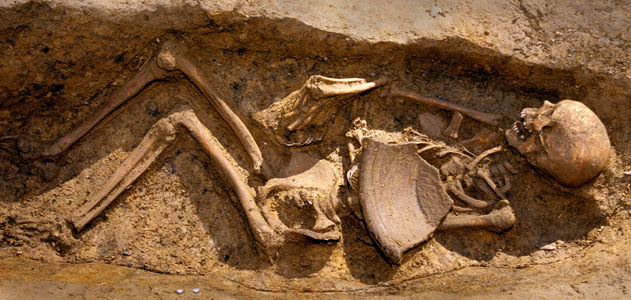Forensic Case Files: Murder of a Colonial Servant
/
The Chesapeake Bay area was a hotspot of colonization in the 1600’s, giving rise to colonial settlements such as Jamestown, Virginia and Providence, Maryland. People journeyed from England in droves, leaving overcrowded Europe in hopes of a new life in the New World. Those who could afford it became landowners. Those who couldn't ― 70 to 85% of all immigrants ― were forced to take posts as indentured servants.
The life of an indentured servant in the colonies was hard. A contract was signed with a landowner, pledging seven years of service carrying out all the heavy work on the farm ― hauling, butchering, construction, harvesting and drying tobacco. In exchange for this labour, the landowner paid the servant’s way from Europe, and then provided food and shelter during the term of the indenture. At the end of the term, the servant was released from the agreement, given fresh clothes, several farm tools, three barrels of corn and the right to purchase fifty acres of their own land. For those that had nothing, indenture was the chance to become an independent landowner.
Archaeologist Dr. Al Luckenbach is the founder and director of the Lost Towns Project, a group dedicated to discovering and excavating lost Colonial towns of the 17th century. In 2003, Luckenback’s project involved a small tobacco plantation owned by William Neale, built in 1662 and abandoned in 1677, following Neale's death. The footprint of the house still survives in the soil stains left from wooden posts driven into the ground, marking the foundation. But it was in the basement of this structure that the most startling discovery was made ― a carelessly and hastily dug grave.
The grave was dug using a broken pottery milk pan (a wide mouthed dish used to separate milk from cream in Colonial times), which was later discarded on top of the deceased and buried with him. Clearly no care was taken with the grave, not even ensuring the grave was long enough to lay out the body. Instead, the body was folded into the grave, bending the legs to fit it into the available space.
There were several possible explanations for the body in the basement. Funerals were expensive and landowners were poor. A law passed in 1661 prohibited the inappropriate burial of servants, so landowners were legally responsible to pay for a proper burial, and a clandestine burial would avoid those costs. However, another possible explanation for a secret burial is the concealment of a murder.
Luckenbach called in forensic anthropologist Dr. Doug Owsley to examine the remains. Those bones told the real story, a story of hardship and harsh abuse. The remains were those of a fifteen- or sixteen-year-old boy, so young that the epiphyseal fusion on his arms and legs was incomplete. The muscle attachment points in his arms and shoulders were very robust, indicating a life of hard manual labour with a lot of heavy lifting and carrying. There was a healed break in his right elbow. Multiple vertebrae in his spine were deformed by Schmorl’s nodes (depressions in the body of the vertebra, caused by compression trauma). His spine also showed signs of the early stages of tuberculosis. Nineteen of the boy’s thirty teeth had significant cavities, some large enough to obliterate the crowns of several molars; absesses from these cavities certainly caused severe pain and, likely, blood poisoning as well.
Worst of all, his right arm spoke of his death. One of his metacarpals, the narrow bones that connect the carpals in the wrist to the phalanges in the fingers, was fractured. A second fracture was found in the radius, one of the two bones in the lower arm. It was a longitudinal fracture that radiated down the shaft of the bone from the wrist, exactly lining up with the fractured metacarpal. Those combined breaks tell a sad tale of a sick and weakened servant who was likely beaten by his master, attempting to block a blow with his right arm, breaking both his hand and arm in the process. Owsley suspects that this altercation lead to directly to the boy’s death. In an attempt to hide the murder, the landowner buried the body in his basement, where the remains would lie for over three hundred years before coming to light.
This excavation, as well as many others from the Chesapeake Bay area, are currently on display at the Smithsonian Institution Natural History Museum as part of 'Written in Bone - Forensic Files of 17th-Century Chesapeake', on display until January 6, 2013.
Photo credit: Chip Clark, Smithsonian Institution



 73.3%
73.3%